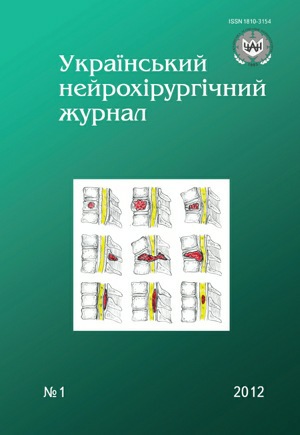Influence of presurgical cerebral and extracerebral factors on lethality in surgical treatment of hemorrhagic stroke
DOI:
https://doi.org/10.25305/unj.57747Keywords:
hemorragic strokes, lethality, cerebral and extracerebral factors, organs’ disfunction, multiorgan unsufficiencyAbstract
Introduction. Hemorrhagic strokes are one of principal causes of mortality. As a rule, it is caused by a rupture of arterial aneurisms – in 78.5% patients, arteriovenous malformations – in 8.5%, formation of intracerebral hematomas – in 13%.
Methods. To establish main causes of a stroke 224 patients were examined, of whom 119 survived and 105 died. Surgical treatment of hemorrhagic stroke revealed the highest lethality among patients with intracerebral haematomas, which is attributable to patient’s old age and a large volume of haematomas.
Results. There are primary and secondary cerebral determining factors. The main cause of death among patients was primary cerebral factors i.e. volume and localization of hematomas. Lethality is higher in case of intracerebral hematomas and definitely lower in case of subarachnoid hemorrhages. As secondary cerebral factors, brain edema and axial tonsilla herniation play a decisive role a decision role. Expressed extracerebral dysfunction is observed only in 1.3% of the dead patients (3 points according to the Sequential Organ Failure Assessment (SOFA) score, and somewhat more often in patients with organ dysfunction (1–2 points).
Conclusions. The most objective marker of lethality is the sum of SOFA score points. If it exceeded 7 points, lethality reached 90%, and at 0–3 points — only 44%. The above data show that that the basic treatment and preventive hospital interventions should be aimed at eliminating secondary cerebral factors: improvement of cerebral perfusion and oxygenation, and brain edema management.
References
1. Zozulya YuP, Voloshyn PV, Mishchenko TS [et al.]. Suchasni pryntsypy diahnostyky ta likuvannya khvorykh z hostrymy porushennyamy mozkovoho krovoobihu: metod. rekomendatsyy [Modern principles of diagnosis and treatment of patients with acute stroke: Guidlines]. Kyiv; 2005. Ukrainian.
2. Ishizaki T, Imanaka Y, Sekimoto M, Fukuda H, Mihara H; Treatment of Subarachnoid Hemorrhage Expert Group. Comparisons of risk-adjusted clinical outcomes for patients with aneurysmal subarachnoid haemorrhage across eight teaching hospitals in Japan. J Eval Clin Pract. 2008 Jun;14(3):416-21. [CrossRef] [PubMed]
3. Abbaszade Elchin Zeynalabdin ogly. Vnutrimozgovyye i vnutrizheludochkovyye krovoizliyaniya v rezultate razryva arterialnykh anevrizm perednikh otdelov villiziyeva kruga. Klinika, diagnostika, lecheniye [Intracerebral and intraventricular hemorrhages in result of aneurysms rupture of the anterior half-ring of arterial circle of the brain (clinic, diagnosis, treatment)] [dissertation]. Kiev (Ukraine): Romodanov Neurosurgery Institute; 2011. Russian.
4. Baue AE, Faist E, Fry DE. Multiple organ failure: pathophysiology, prevention and therapy. New York: Springer; 2000.
5. Zygun DA, Doig CJ, Gupta AK, Whiting G, Nicholas C, Shepherd E, Conway-Smith C, Menon DK. Non-neurological organ dysfunction in neurocritical care. J Crit Care. 2003 Dec;18(4):238-44. [CrossRef] [PubMed]
6. Sizov DN, Kostyuchenko AL, Belskikh AN. Sindrom posledovatelnykh organnykh povrezhdeniy v kriticheskikh sostoyaniyakh [Syndrome of consecutive organ damage in critical conditions]. Anesteziologiya i reanimatologiya. 2007(2):22-5. Russian.
7. Kizhayev YeS, Zake IO. Poliorgannaya nedostatochnost v intensivnoy terapii [Multiple organ disfunction in the intensive care]. Vestnik Intensivnoy Terapii. 2004(1):14-8. Russian.
8. Gruber A, Reinprecht A, Illievich UM, Fitzgerald R, Dietrich W, Czech T, Richling B. Extracerebral organ dysfunction and neurologic outcome after aneurysmal subarachnoid hemorrhage. Crit Care Med. 1999 Mar;27(3):505-14. [CrossRef] [PubMed]
Downloads
Published
How to Cite
Issue
Section
License
Copyright (c) 2012 Olga Kamenska, Leonard Chepkiy, Orest Tsimeyko, Volodymyr Moroz

This work is licensed under a Creative Commons Attribution 4.0 International License.
Ukrainian Neurosurgical Journal abides by the CREATIVE COMMONS copyright rights and permissions for open access journals.
Authors, who are published in this Journal, agree to the following conditions:
1. The authors reserve the right to authorship of the work and pass the first publication right of this work to the Journal under the terms of Creative Commons Attribution License, which allows others to freely distribute the published research with the obligatory reference to the authors of the original work and the first publication of the work in this Journal.
2. The authors have the right to conclude separate supplement agreements that relate to non-exclusive work distribution in the form of which it has been published by the Journal (for example, to upload the work to the online storage of the Journal or publish it as part of a monograph), provided that the reference to the first publication of the work in this Journal is included.









